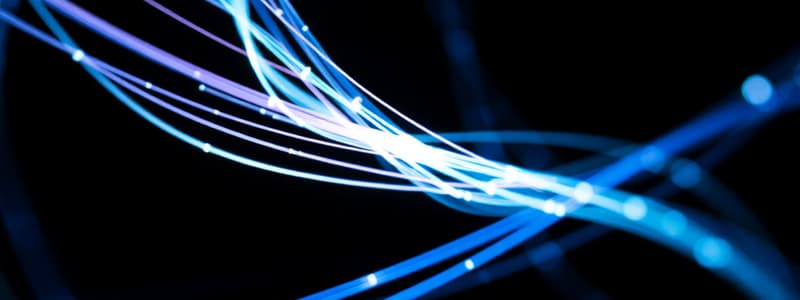Podcast
Questions and Answers
What is the primary purpose of optical fibers?
What is the primary purpose of optical fibers?
- To protect against moisture and physical damage
- To transmit light signals over long distances (correct)
- To transmit electrical signals over short distances
- To provide insulation for electrical wiring
Which component of a fiber optic cable is responsible for reflecting light back into the core?
Which component of a fiber optic cable is responsible for reflecting light back into the core?
- Buffer coating
- Core
- Cladding (correct)
- Outer sheath
Which color is NOT part of the standard fiber optic cable color code?
Which color is NOT part of the standard fiber optic cable color code?
- Yellow
- Pink (correct)
- Green
- Blue
What should be used to dispose of fiber fragments safely?
What should be used to dispose of fiber fragments safely?
How should chemicals be stored when working with fiber optics?
How should chemicals be stored when working with fiber optics?
What is the diameter of a typical optical fiber compared to?
What is the diameter of a typical optical fiber compared to?
Which part of the fiber optic cable is primarily responsible for supporting the fiber's structure?
Which part of the fiber optic cable is primarily responsible for supporting the fiber's structure?
Which of the following is an appropriate safety precaution when working with fiber optics?
Which of the following is an appropriate safety precaution when working with fiber optics?
What type of signals can optical fibers transmit?
What type of signals can optical fibers transmit?
What is the primary function of the core in a fiber optic cable?
What is the primary function of the core in a fiber optic cable?
Flashcards are hidden until you start studying
Study Notes
Introduction to Fiber Optics
- Fiber optics are thin glass strands, the diameter of a human hair, used to transmit light signals over long distances.
- They are arranged in bundles called optical cables.
- Fiber optics can transmit analog or digital signals including voice, data and/or video information.
Types of Fiber
- There are different types of fiber, but they are not detailed in this text.
Fiber Optic Design
- Fiber optic cables have three key components:
- Core: The thin glass center where light travels.
- Cladding: The outer optical material surrounding the core that reflects light back into the core.
- Buffer Coating: A plastic coating that protects the fiber from damage and moisture.
Color Coding
- There is a standard color code for fiber optic cables:
- Blue
- Red
- Orange
- Black
- Green
- Yellow
- Brown
- Violet
- Slate
- Rose
- White
- Aqua
Safety Precautions
- Store and label chemicals safely.
- Use chemicals only in well-ventilated areas.
- Keep chemicals away from skin, eyes and ingestion.
- Be familiar with COSHH (Care Of Substances Hazardous to Health) guidelines.
- Dispose of all fiber fragments in a suitable container.
- Do not pick up fiber fragments by hand; use sticky tape instead.
- Wear protective goggles and gloves before working with fiber.
- Workers must avoid smoking while working with fiber.
Studying That Suits You
Use AI to generate personalized quizzes and flashcards to suit your learning preferences.





